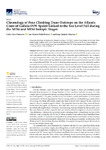Chronology of Four Climbing Dune Outcrops on the Atlantic Coast of Galicia (NW Spain) Linked to the Sea Level Fall during the MIS6 and MIS4 Isotopic Stages

Ver/Abrir
Use este enlace para citar
http://hdl.handle.net/2183/30347Colecciones
- Investigación (FCIE) [1227]
Metadatos
Mostrar el registro completo del ítemTítulo
Chronology of Four Climbing Dune Outcrops on the Atlantic Coast of Galicia (NW Spain) Linked to the Sea Level Fall during the MIS6 and MIS4 Isotopic StagesFecha
2022-02-23Cita bibliográfica
Arce-Chamorro, C.; Vidal-Romaní, J.R.; Sanjurjo-Sánchez, J. Chronology of Four Climbing Dune Outcrops on the Atlantic Coast of Galicia (NW Spain) Linked to the Sea Level Fall during the MIS6 and MIS4 Isotopic Stages. J. Mar. Sci. Eng. 2022, 10, 312. https://doi.org/10.3390/jmse10030312
Resumen
[Abstract] Numerous sandy deposits, interpreted as the remains of old climbing dunes, are preserved on the cliffy coast of Galicia (northwest Spain). These deposits can be found both in open coastal areas and in the interior of the Galician Rias. In this paper, a formation age is established for four aeolianite outcrops dating back to 166 ± 9 ka, 131 ± 6 ka, 128 ± 18 ka and 62 ± 3 ka, using the IRSL290 signal of feldspars. These sands were mobilised by coastal winds from a sea level lower than the current one during MIS6 and MIS4. The sea level fall during these regressive episodes shifted the coastline several kilometres away from its current position. This favoured the action of the wind blowing over the emerged coastal strip, which acted as a source area for aeolian sands. During warmer episodes, such as the Eemian and the Holocene, the advance of the sands onto the coast was progressively reduced as the sea level rose and the oceanic waters flooded the continental shelf.
Palabras clave
Coastal aeolianites
Climbing dunes
pIR-IRSL dating
Middle and Upper Pleistocene
Glacioeustasy
Aeolian accretion
Atlantic coast of Galicia (NW Spain)
Climbing dunes
pIR-IRSL dating
Middle and Upper Pleistocene
Glacioeustasy
Aeolian accretion
Atlantic coast of Galicia (NW Spain)
Versión del editor
Derechos
Atribución 4.0 Internacional
ISSN
2077-1312






